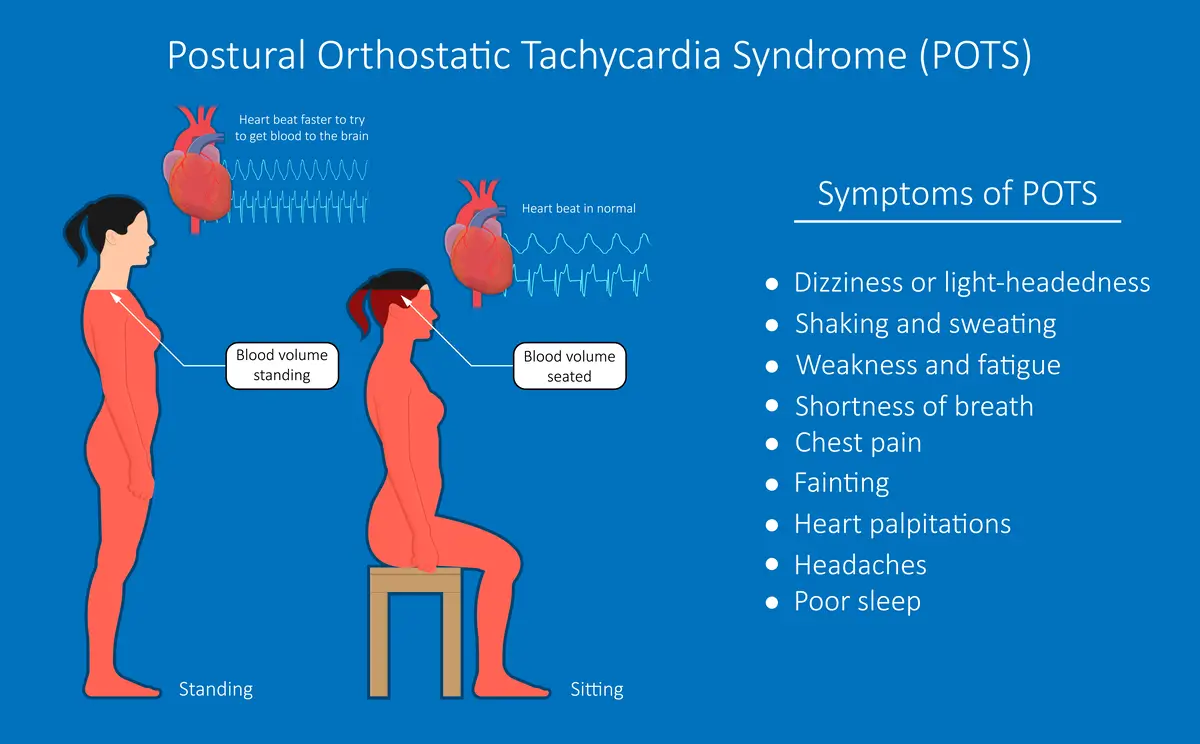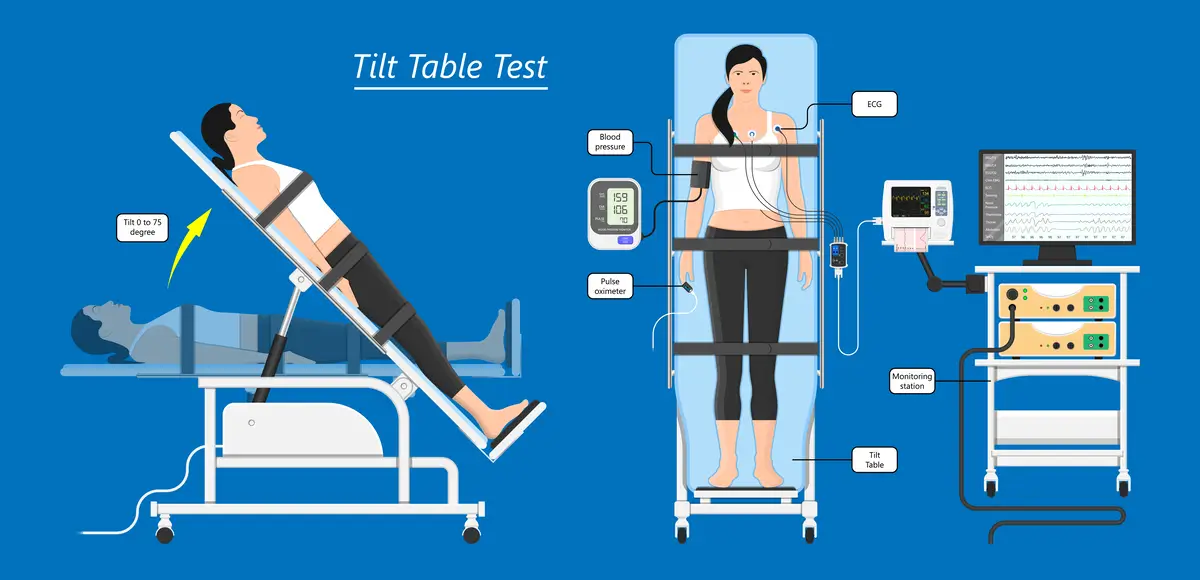TILT TABLE TEST


The tilt table test, also known as an upright tilt test or head-up tilt test, is a medical procedure used to evaluate the body's response to changes in position. It is predominantly used to diagnose and determine the causes of fainting episodes, also known as syncope.
Introduction to the Tilt Table Test
The Tilt Table Test is a medical procedure that involves a patient being strapped to a table that can be tilted from a horizontal to a vertical position. The purpose of this test is to evaluate and diagnose conditions related to blood pressure and heart rate. By observing how the patient's body responds to the changing position, doctors can identify abnormalities caused by an abnormal change such as low blood pressure, fainting, or autonomic nervous system disorders. During the test, the patient's vital signs are closely monitored while the table is gradually tilted upwards. This procedure causes an abnormal change in your blood pressure, so it offers valuable insights into a patient's cardiovascular health and helps guide appropriate treatment plans.
How the Tilt Table Test Works
This test is a diagnostic procedure used to evaluate patients with symptoms of unexplained fainting, dizziness or lightheadedness. During the test, the patient is asked to lie flat and securely strapped to a table that can be tilted upward to various angles. The mechanism of the Tilt Table Test involves mimicking the changes in position as the table is tilted which often triggers symptoms in patients. By tilting the table, it redistributes blood flow in the body and induces changes in blood pressure and heart rate. This allows doctors to observe how the patient's cardiovascular system responds in different positions.
To measure blood pressure and heart rate, the patient's vital signs are continuously monitored throughout the test. Blood pressure cuffs are placed on the patient's arm or leg, and electrodes are attached to the chest for monitoring heart rate. This enables doctors to identify any abnormal or exaggerated changes in blood pressure and heart rate that may explain the patient's symptoms. In some cases, an intravenous (IV) line may be inserted into a vein in your arm for further monitoring or administration of medication if necessary. Overall, the Tilt Table Test provides valuable insights into the patient's cardiovascular function and helps guide treatment decisions.
Types of Conditions Diagnosed with the Tilt Table Test
The tilt table test is a diagnostic procedure that helps identify certain medical conditions. One of the conditions that can be diagnosed with this test is vasovagal syncope, which is a sudden drop in heart rate and blood pressure that leads to fainting.
Another condition that can be detected ispostural orthostatic tachycardia syndrome (POTS), which is a type of dysautonomia characterised by an abnormal increase in heart rate upon standing.

Orthostatic hypotension is another condition that the tilt table test can identify, as it causes a drop in blood pressure when a person stands up.
Additionally, the test can also determine if a person has a form of autonomic dysfunction, such as autonomic neuropathy, which affects the nerves that control involuntary bodily functions.
Overall, the tilt table test is a valuable tool for diagnosing various conditions related to heart rate and blood pressure regulation.
Who Should Consider a Tilt Table Test
A tilt table test is a diagnostic procedure that helps healthcare professionals determine the cause of symptoms such as fainting, syncope, and lightheadedness. This test may be recommended for individuals who experience unexplained fainting or syncope, especially if it occurs frequently or leads to recurrent falls.
It is also used to evaluate vasovagal syncope, a condition in which a person experiences a sudden drop in blood pressure and heart rate, often triggered by specific triggers or situations. Suspected neurocardiogenic syncope, a type of fainting caused by an abnormal reflexive response of the autonomic nervous system, is another reason to consider a tilt table test. Additionally, individuals who suffer from persistent dizziness or lightheadedness and have not found a clear cause for their symptoms may benefit from undergoing this test.
Benefits of the Tilt Table Test
The tilt table test is a diagnostic procedure used to evaluate patients with symptoms such as fainting or lightheadedness. It helps to determine the underlying cause of these symptoms by monitoring a patient's blood pressure and heart rate while they are tilted at various angles. This test can provide valuable information about the functioning of the cardiovascular system and assist in the development of an appropriate treatment plan.
Early Detection of Syncope and Related Conditions
The tilt table test has significant benefits in the early detection of syncope and related conditions. By subjecting the patient to lie flat on a special table and testing it to various positions and angles on a tilting table, doctors can observe the cardiovascular responses and determine the underlying causes of unexplained episodes of fainting. This test helps in identifying disorders such as vasovagal syncope, orthostatic hypotension, and autonomic dysfunction, allowing for prompt diagnosis and appropriate treatment. Early detection is crucial in preventing complications and improving the overall management of these conditions.
Differential Diagnosis of Syncope Causes
This test is also a valuable diagnostic tool for evaluating the causes of syncope. It allows for a differential diagnosis by measuring the response of the cardiovascular system to changes in position. This test provides benefits such as identifying neurocardiogenic syncope, vasovagal syncope, and other causes of fainting. By conducting the tilt table test, healthcare professionals can accurately determine the underlying cause of syncope, leading to appropriate treatment and management options.
Tailored Treatment Plans Based on Test Results
The tilt table test provides various benefits, one of which is the ability to create tailored treatment plans based on the results. By analysing the patient's response to the test, healthcare professionals can identify specific issues and develop targeted interventions. This personalised approach ensures that individuals receive the most effective treatment for their condition, ultimately improving their overall well-being and quality of life.
Identifying the Cause of Fainting Episodes
In addition to the benefits mentioned above, this test may also help identify the cause of fainting episodes. By observing the blood pressure monitor during the test, healthcare providers can gain valuable insights into the patient's cardiovascular health and identify any abnormalities or triggers for their symptoms.
Evaluating the Role of Blood Pressure and Heart Rate
A tilt table test can provide important information about how a patient's blood pressure and heart rate respond to changes in posture. It helps healthcare providers evaluate the body's cardiovascular reflexes and determine if there are any dysfunctions or irregularities that may be contributing to the patient's symptoms.
The Tilt Table Test Procedure
The testing process involves strapping a patient to a table that can be tilted to different angles. Before the test, patients are instructed to fast for a certain period, and they are also advised to avoid certain medications. The test is typically performed in a laboratory or clinic setting equipped with specialised equipment, including a tilt table. During the procedure, healthcare professionals closely monitor the patient's heart rate and blood pressure. This allows them to assess the body's response to changes in position and determine the underlying cause of the symptoms.

Preparing for a Tilt Table Test
Why Fasting Is Required Before the Test
Before a tilt table test, patients will often be instructed to fast for a designated period of time, usually several hours. This is done to ensure accurate results, as eating or drinking before the test can affect the body's response to changes in posture and may interfere with the accuracy of blood pressure and heart rate measurements.
Other Pre-test Instructions to Follow
In addition to fasting, patients may also be given specific instructions by their healthcare provider to follow before the test. This may include avoiding certain medications or substances that could interfere with the test results, such as caffeine or alcohol. It is important to carefully follow these instructions to ensure the test is performed accurately.
The Importance of Communication With Your Healthcare Provider
Before the test, patients must communicate openly and honestly with their healthcare provider. This includes providing a complete medical history, detailing any symptoms experienced, and asking any questions or concerns they may have about the procedure. Building a strong patient-provider relationship and clear communication can help ensure the best possible outcomes for the tilt table test.
What to Expect During the Tilt Table Test
During the test, the table will be gradually tilted to an upright position. The patient may experience symptoms such as dizziness, lightheadedness, or a temporary decrease in blood pressure and heart rate. These symptoms are closely monitored, and the test is stopped if the patient becomes faint or loses consciousness. The duration of the test may vary, but it typically takes about 30 to 60 minutes to complete.
Duration of the Test
The duration of the Tilt Table Test typically ranges from 20 to 45 minutes. The patient is secured to a table that can be tilted to various angles to simulate changes in blood pressure and help diagnose conditions like orthostatic intolerance and syncope. The duration may vary depending on the purpose of the test and the patient's response to the tilting.
Potential Sensations During the Test
During a tilt table test, patients may experience a range of sensations. These can include dizziness, lightheadedness, sweating, nausea, heart palpitations, and a rapid heartbeat. Some people may also feel a tingling sensation in their extremities or have a temporary loss of consciousness. Some may faint during the test too but this is a very rare case. Patients need to inform the healthcare provider about any discomfort or unusual sensations they may experience during the test.
Contraindications and Precautions
Patients need to inform their healthcare provider about any medical conditions they have or medications they are taking, as certain conditions or drugs may affect the results of the test. Patients who are pregnant or have certain medical conditions, such as significant heart disease, may not be suitable candidates for the procedure. The healthcare provider will assess each patient's circumstances to determine if a tilt table test is appropriate.
What to Expect After a Tilt Table Test
Recovery and Post-test Care
After a tilt table test, patients will typically be monitored for a short period to ensure their vital signs have returned to baseline. If the test was performed on an outpatient basis, patients will generally be allowed to go home after this monitoring period. However, it is important to follow any specific post-test care instructions provided by the healthcare provider.
Interpreting the Test Results
The results of a tilt table test will be interpreted by a healthcare provider, typically a cardiologist or another specialist trained in the field of cardiovascular medicine. They will analyse the data obtained during the test, including changes in blood pressure, heart rate, and symptoms experienced. These results will be used to make a diagnosis, determine the underlying cause of the patient's symptoms, and develop an appropriate treatment plan.
Follow-up Appointments and Next Steps
After a tilt table test, patients will usually have a follow-up appointment with their healthcare provider to discuss the test results and next steps. This may include further diagnostic tests, such as blood work or imaging studies, or adjustments to the patient's current treatment plan. Regular follow-up appointments will be scheduled as needed to monitor the patient's progress and ensure the effectiveness of the chosen treatment approach.
Costs of Tilt Table Test In Singapore
The costs of a Tilt Table Test in Singapore can vary depending on where you choose to have the procedure done. On average, the cost can range from SGD $300 to SGD $1000. However, it is important to note that these prices may not include additional fees such as consultation fees, laboratory tests, or follow-up appointments. For patients with medical insurance coverage, the cost of the test may be partially or fully covered, depending on the policy. It is advisable to check with your insurance provider beforehand to understand the extent of coverage for this specific procedure.
Conclusion
In conclusion, the Tilt Table Test provides several benefits in diagnosing various medical conditions related to fainting or lightheadedness. This non-invasive procedure offers valuable insights into the cardiovascular system's response to changes in the body's position. It helps identify the underlying causes of syncope and aids in the development of suitable treatments for heart diseases.
Frequently Asked Questions
Is the Tilt Table Test Painful or Uncomfortable?
The Tilt Table Test is generally not painful but can be uncomfortable for some individuals. During the test, the patient is secured to a table that can be tilted to different angles. This change in position can cause mild discomfort such as lightheadedness and nausea. However, the test is a safe procedure, typically well-tolerated, and any discomfort experienced may be caused by a temporary decrease in blood flow, but it is temporary. It is important to communicate any discomfort or concerns with the healthcare provider to ensure a safe and successful test.
How Long Does the Tilt Table Test Take?
The tilt table test typically takes between 30 to 60 minutes to complete. However, the duration may vary depending on the specific instructions given by the healthcare provider and the patient's specific condition.
Can I Eat or Drink Before the Tilt Table Test?
It is generally recommended to refrain from eating or drinking anything, except for small sips of water, at least 4 hours before a tilt table test. Any food or beverages that you consume can affect the results of the test as the tilt table test may cause nausea. Eating a heavy meal or consuming caffeinated drinks can potentially interfere with the accuracy of the test and make it more difficult to detect abnormalities in your blood pressure and heart rate. It is best to follow the specific instructions given by your healthcare provider to ensure accurate results.

